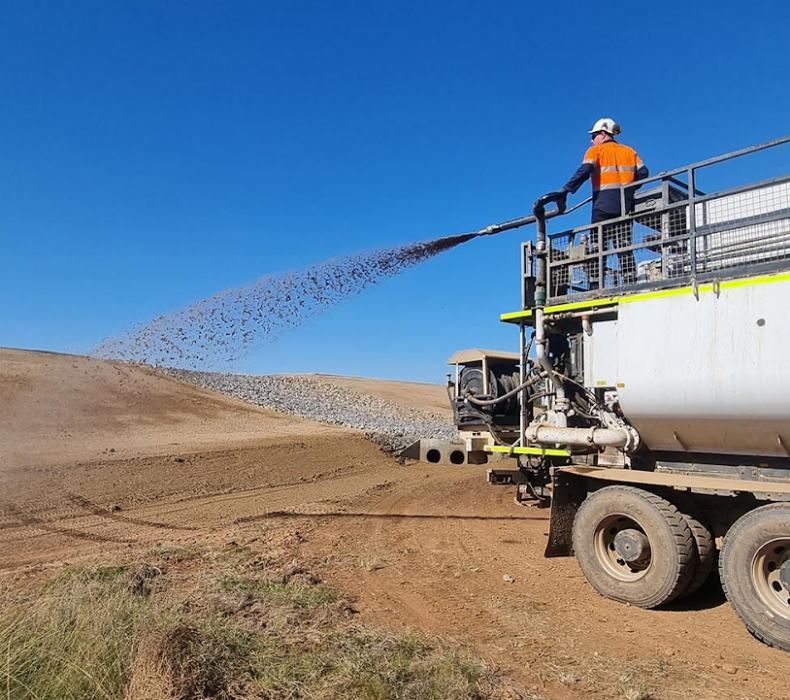Hydromulching is a sophisticated technique used in landscape management and erosion control, offering a range of benefits for both new and existing landscapes. This method combines seeds, mulch, and other essential components into a slurry that is applied to soil surfaces using specialized equipment. The result is a robust system that promotes vegetation growth and enhances soil stability. In this article, we will explore how hydromulching works and its advantages in landscape establishment and soil stability.
Understanding Hydromulching
Hydromulching, also known as hydraulic mulch seeding or hydroseeding, is a process where a mixture of water, mulch, seeds, and often fertilizers and soil amendments is sprayed onto soil surfaces. This technique is widely used in erosion control, reforestation, and landscape restoration projects. The primary components of the hydromulching mixture include:
- Hydraulic Mulch: Typically made from wood fibers, paper, or other organic materials, hydraulic mulch helps retain moisture and provides a protective layer on the soil surface.
- Seeds: Selected based on the desired vegetation and the local climate, seeds are mixed into the slurry to promote rapid germination and establishment.
- Fertilizers and Soil Amendments: These are included to provide essential nutrients to the growing plants and enhance soil quality.
The Benefits of Hydromulching
1. Accelerated Vegetation Growth
One of the most significant advantages of hydromulching is its ability to accelerate vegetation growth. The slurry creates a protective cover that helps seeds germinate faster by retaining moisture and providing a conducive environment for root development. This is particularly beneficial in areas with poor soil quality or challenging weather conditions.
2. Enhanced Erosion Control
Hydromulching provides an effective barrier against soil erosion. The mulch layer stabilizes the soil surface and reduces the impact of rainfall, which can otherwise lead to soil displacement and degradation. By preventing erosion, hydromulching protects the integrity of the landscape and minimizes sediment runoff into nearby water bodies.
3. Improved Soil Moisture Retention
The mulch component of the hydromulching mixture acts as a moisture reservoir, reducing evaporation and ensuring that the soil remains consistently moist. This is crucial for seedling survival, especially in arid or semi-arid regions where water availability can be limited.
4. Cost-Effective and Efficient
Compared to traditional seeding methods, hydromulching is often more cost-effective and efficient. The application process covers large areas quickly and uniformly, reducing the need for manual labor and multiple passes over the site. Additionally, the technique minimizes seed wastage and ensures even distribution.
Hydromulching Application
1. Preparation and Site Assessment
Before applying hydromulching, it is essential to prepare the site properly. This involves clearing the area of debris, rocks, and other obstacles. A thorough site assessment helps determine the appropriate seed mix and any additional soil amendments needed. The soil should be graded to ensure proper drainage and a smooth surface for the application.
2. Mixing and Application
The hydromulching mixture is prepared by combining the mulch, seeds, water, and any additives in a specialized tank. The slurry is then sprayed onto the prepared soil using a hydraulic pump and nozzle system. This application method ensures a uniform coverage and allows the mixture to adhere to the soil surface effectively.
3. Post-Application Care
After the hydromulching application, it is crucial to monitor the site and provide appropriate care. Regular watering may be required to maintain soil moisture and support seed germination. Additionally, monitoring for pests and diseases ensures that the newly established vegetation remains healthy and robust.
4. Long-Term Benefits
The benefits of hydromulching extend beyond initial establishment. As the vegetation matures, it contributes to long-term soil stability and landscape sustainability. The plant roots bind the soil, further reducing erosion and promoting a healthy, resilient ecosystem.
Conclusion
Hydromulching is a valuable technique in modern landscape management, offering a range of benefits for vegetation establishment and soil stability. By combining seeds, mulch, and essential nutrients into a slurry, hydromulching provides an effective solution for erosion control, moisture retention, and rapid vegetation growth. The efficiency and cost-effectiveness of hydromulching make it a preferred choice for large-scale projects and challenging environments. As a result, hydromulching plays a critical role in enhancing landscape health and ensuring the long-term sustainability of our natural environments.



